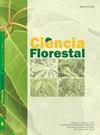Extraction and characterization of two residual lignins from eucalyptus wood
IF 0.5
4区 农林科学
Q4 FORESTRY
引用次数: 0
Abstract
Lignin, the second most abundant biopolymer on the planet, has properties that can be widely explored, moving from waste to products with high added value. Therefore, this work aimed to extract and characterize Klason and Kraft lignins from sawdust and black liquor, considered industrial waste. The raw material used was Eucalyptus grandis chips. To obtain Klason lignin according to TAPPI 222 om-02 (2002), part of the chips were transformed into sawdust. To obtain Kraft lignin, another part of the chips passed through a digester to obtain black liquor, which was subsequently subjected to acid precipitation. The characterization of lignins was performed by granulometry analysis, scanning electron microscopy with elemental chemical analysis (EDS), transmission electron microscopy, medium infrared spectroscopy, thermogravimetric analysis and differential calorimetry. Microscopy analyzes showed irregular structures of various shapes, including spherical structures, most evident and frequent in Kraft lignin. The elementary chemical analysis showed that the lignin washing process was satisfactory, due to the small percentage of sulfur detected in the samples. The results of the granulometry confirmed that the lignins had micrometric dimensions. The medium infrared spectra showed the characteristic peaks of the chemical composition of lignin. The thermal analysis showed three ranges of degradation, attributed to the drying of the samples, degradation of the hemicelluloses and the lignin itself. All results confirmed the obtaining of Klason and Kraft lignins. Therefore, the techniques were satisfactory in transforming waste into lignin with the potential for a variety of commercial applications, mainly in the chemical and pharmaceutical industries.桉树木材中两种残留木质素的提取与表征
木质素是地球上含量第二丰富的生物聚合物,其特性可以广泛探索,从废物转化为高附加值产品。因此,本工作旨在从木屑和黑液中提取和表征Klason和Kraft木质素,这些木质素被认为是工业废物。使用的原材料是巨桉切片。为了根据TAPPI 222 om-02(2002)获得Klason木质素,将部分切片转化为木屑。为了获得卡夫木质素,另一部分木片通过蒸煮器获得黑液,随后进行酸沉淀。通过粒度分析、扫描电子显微镜和元素化学分析(EDS)、透射电子显微镜、中红外光谱、热重分析和差示量热法对木质素进行了表征。显微镜分析显示,各种形状的不规则结构,包括球形结构,在硫酸盐木质素中最为明显和常见。元素化学分析表明,木质素洗涤过程是令人满意的,因为在样品中检测到的硫百分比很小。粒度测定的结果证实木质素具有微米尺寸。中红外光谱显示了木质素化学组成的特征峰。热分析显示了三个降解范围,归因于样品的干燥、半纤维素和木质素本身的降解。所有结果都证实了Klason和Kraft木质素的获得。因此,这些技术在将废物转化为木质素方面令人满意,具有多种商业应用的潜力,主要用于化学和制药行业。
本文章由计算机程序翻译,如有差异,请以英文原文为准。
求助全文
约1分钟内获得全文
求助全文
来源期刊

Ciencia Florestal
农林科学-林学
CiteScore
0.80
自引率
0.00%
发文量
85
审稿时长
18-36 weeks
期刊介绍:
The journal Forest Science was established in 1991 with the goal of being a vehicle for dissemination which are published works tércnico-scientific forest-related, the following bodies crowded the Centro de Ciências Rurais of Universidade Federal de Santa Maria:
- Centro de Pesquisas Florestais - CEPEF
- Programa de Pós-graduação em Engenharia Florestal - PPGEF
- Departamento de Ciências Florestais - DCFL
MISSION:
Publish scientific papers, technical notes, and literature reviews related to the area of forest sciences.
 求助内容:
求助内容: 应助结果提醒方式:
应助结果提醒方式:


